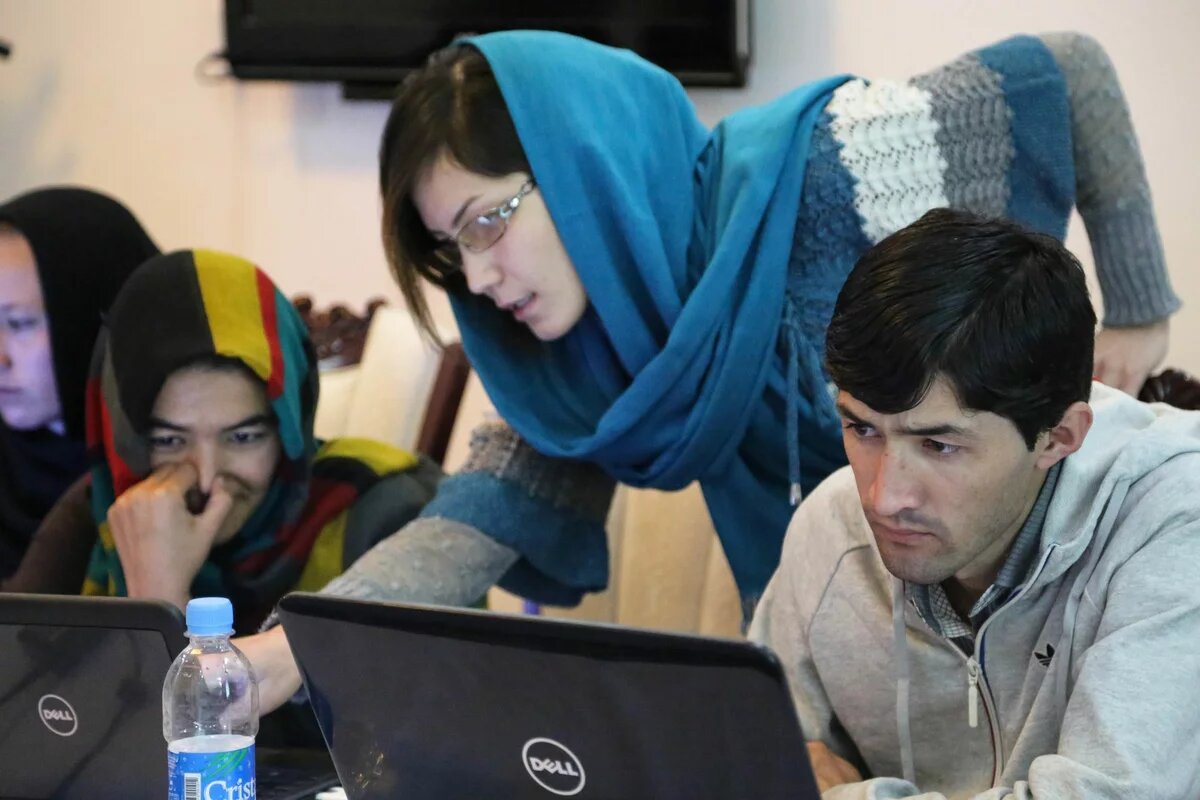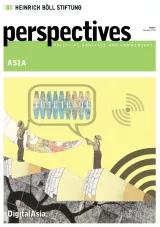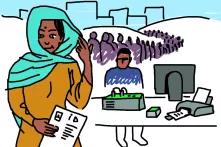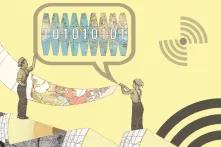Social media has played a critical role in influencing change in Afghanistan. The potential anonymity of the internet offers great opportunities for women.

This article is part of our special on Digital Asia.
After the Taliban regime was toppled in 2001, broad access to digital telecommunication services became a reality in Afghanistan, bringing with it substantial social changes. Millions of Afghans today are connected and equipped with mobile phones and other mobile devices, allowing them to access information as never before and engage in sociopolitical discourse.
It has been 15 years since the democratization process started to take root in Afghanistan. One outcome of this process was the establishment of social media, which impacts the everyday lives of individuals in Afghanistan. But has social media also played a role in transforming Afghanistan into a more diverse and democratic society?
Since the introduction of 3G internet services in 2012, the number of internet users has increased considerably. Today, more than 10 percent of the population is online and partakes in social media activities, up from 0.1 percent in 2004. Social media easily enables its users not only to receive information, but also to produce their own content, whereas classic media forms, such as printed newspapers, radio, and television, require far more resources and complex processing to be produced. Moreover, it allows the user to create his or her own personal networks and share information globally and instantaneously. The low costs to create and obtain individually tailored information make social media especially attractive for a war-torn country.
Even though the media landscape has developed since the fall of the Taliban, Taliban groups continue to intimidate and attack those journalists who report about war crimes, in particular rape and topics that relate to what the Taliban has labeled the “breaching of religious norms.” Consequently, the physical production of good media outlets is often nearly close to impossible or associated with unbearable risks for journalists. By contrast, social media allows for someone to report on topics that might incur anger by some groups while staying anonymous at the same time.
Furthermore, in a mountainous country such as Afghanistan, with its diverse ethnic, linguistic, and tribal cultures, which often prevent people from becoming more interconnected, social media has the potential to unite different cultural groups. It can overcome those geographic and cultural barriers and include people in discussions who live in remote and inaccessible areas. Nowadays, people share their concerns about issues such as the negative effects of administrative corruption on their lives or communicate their concerns regarding political events such as elections.
Who are the users in Afghanistan, and which apps do they use?
Hardly surprising, most of the users belong to the generation of digital natives. These are young people who grew up in the age of the internet and have been exposed to information technologies all of their lives. Most users have a certain level of basic education and are more likely to come from urban middle-class families, which have comparatively more access to smartphones and technological devices. However, there are also a growing number of internet users in rural areas.
As in most countries around the world, Facebook is the most popular social media platform in Afghanistan. Having grown rapidly in the wake of 3G internet services, the number of Afghanistan-based subscribers reached 2,600,000 in 2016, with 86 percent being male and 14 percent female. Before the construction of optical fiber grids in the late 2000s, social media was limited to a very manageable number of online chat rooms and blogs. Weblogs were the first form of social media, which social activists still use today to promote political issues. The founding of web hosts in the neighboring country Iran paved the way for the success of blogs in Afghanistan. Due to the growing popularity and proliferation of weblogs, social bookmarks and newsgroups emerged to provide updates about websites in Pashtu, Dari, and English, as well as to highlight and rate selected articles. Sometimes the managers of these portals also contribute their own editorials.
These aspects make social media attractive for young Afghans, as they assess the various features of different applications and develop individual usage strategies. For example, Facebook is used by Afghans for reaching the public or large groups of people, whereas WhatsApp, Viber, and Snapchat are mostly used for bilateral, closed-group communications. These apps are especially popular among women in Afghanistan, as they use the apps to communicate privately with male friends.
The internet as an access tool to Western fashion
Overall, Afghan users create and share individual news items that are linked to their ethnicity, local region, religion, community, or other cultural characteristic they identify with. Young Afghans often use the internet to inform themselves about specific lifestyle trends. Via fashion blogs, they learn about global consumer trends and get in touch with what is happening outside of Afghanistan. As most Afghans do not travel internationally, the internet opens up enormous opportunities to gain insights into other worlds. In particular, those users who have more financial resources or work for international NGOs or governmental organizations modify their lifestyles with an eye on up-to-date trends in the West. This is a general trend. Within the last decade, Western fashion rapidly emerged in the bigger cities, and to some extent in more remote and rural areas as well.
Developing individual identities
Afghan users not only use social media to consume and get new fashion inspiration, but also to re-create and reshape personal identities. Open platforms and private chat rooms create spaces to exchange and pursue mutual passions. People with similar interests chat about their hobbies and join forces to realize their common goals. This may sound banal, but in a society that is mainly based on family and community ties, open exchanges with other people about your dreams and interests are very rare. As a result, the use of social media encourages many who have developed a taste for fashion or other interests to highlight their individuality and express their preferences among like-minded peers.
The most remarkable sign of this development is the penchant of many social media users to choose a desired surname or create an individual nickname for their accounts. Creating an account provides the chance to practice individuality, since Afghan ID papers traditionally identify a person by her or his father’s name instead of a surname. While nicknames expressed ideological or nationalist notions during the civil war of the 1980s and 1990s, chosen names nowadays are affiliated with more cultural, literal, or historical concepts, such as Farhang (culture), Khorshid (sun), or Meetra (the god of light).
Mobilization platforms for sociopolitical activism
The sociopolitical activities of Afghan internet users are mostly expressed in the form of debates about current policies or the overall security situation. Discussions are not limited to supporters of the government or the opposition. Moreover, the topics and participants in these discussions represent the inherent complexities of Afghan politics, covering ethnicity, religion, sectarianism, modernity proponents, as well as conservative and traditionalist actors. All of these sides engage in social media debates and use the web as an operative platform to mobilize supporters, extend networks, and organize collective actions.
One example is the protest movement Uprising for Change (Rastakhiz-e Taghir), which was created as a response to the massive suicide attack on May 31, 2017, in Kabul – an attack that claimed hundreds of victims. Within the scope of Uprising for Change, a huge number of protesters met in Kabul city and called for government reforms to stop the violence. Sadly, security forces opened fire and killed at least five of the protesters. The Enlightenment Movement (Jonbesh-e Rowshanayi) is another protest movement, which was organized online by young, educated Hazara, an ethnic minority that mostly follows Shiism in Afghanistan. The movement accused the government of the irresponsible implementation of an energy project in Hazarjat in central Afghanistan.
Both of these protest movements broadly benefited from social media, as they managed to mobilize a large group of demonstrators, which would not have been possible through word of mouth. Against the background that it is too dangerous in Afghanistan to spend much time in public distributing flyers or putting up posters, the role of social media as a sociopolitical and cultural mobilizer is a clear asset.
In this regard, social media also presents an opportunity for collective humanitarian action. For instance, after terrorist attacks, hospitals, doctors, and private people made calls for blood donations for the victims on social media platforms. Activists directly posted the needed blood groups and the addresses of the hospitals. Furthermore, online platforms are also an alternative when meeting in public spaces is considered dangerous or unfavorable due to the risk of suicide attacks or missing infrastructure, such as public transport, cafés, or meeting rooms.
Advertising warfare
During their regime, the Taliban strictly opposed any trappings of modernity, such as photography, TV, music, and sports. Recently, though, they have recognized the benefits of social media for their war propaganda and now use Twitter to claim responsibility for attacks. Taliban groups also use social media channels to post videos of attacks to attract followers and recruit new members. In October 2016, for example, the Taliban recorded a drone attack on the Helmand Police Headquarters. Taliban supporters generally cannot be recognized through their profile accounts, as they use aliases and photos of pretty women. However, their open comments show support for the Taliban and other insurgency groups.
The demonstration of support for the Afghan National Army (ANA) shows another relation between warfare and social media. There are a number of photos on online platforms that show women presenting a red rose to ANA soldiers to encourage them and thank them for their sacrifices.
How has social media changed Afghan society?
Social media has become the first source of information for many people in Afghanistan. Whether Afghans are interested in the recent terror attacks or the latest fashion trends, they will first visit social media pages. The availability of this information leads to a process of becoming more aware of social changes. Many people in Afghanistan are now confronted with wide-ranging news that they previously were not exposed to. After all, Afghanistan and its citizens were cut off from news and world events for decades, due to ongoing conflicts and wars. The understanding of Afghanistan’s role in global politics, culture, and consumerism has thus grown. Internet access now evokes a feeling of connectedness to a world and life outside of a war-torn Afghanistan. This may lead to more interest and open-mindedness about new lifestyles, values, and opinions.
Second, social media offers a private sphere for people to communicate about issues that cannot be addressed in public life. Too often, the parents or close family members of young Afghans do not allow private meetings between friends, especially if these friends are of the opposite sex. The many social restrictions – especially that women face – leave little room for one to express their personality. Social media, in this case, can provide a kind of digital safe haven for young people to communicate and freely explore aspects of their own identities. In a society where family comes before the individual, social media is clearly an asset.
Keeping in mind the difficult gender relations in Afghanistan, the private sphere and the potential anonymity of the internet offer great opportunities for women. It gives them the possibility to express their opinions, wishes, and goals, and to present themselves to a certain distinguished public – actions that could be life-threatening in the offline world. Online, they can speak and comment on sensitive topics such as hijabs, religion, women’s rights, abortion, sexuality, sexual harassment, and domestic violence.
Apart from a small number of well-known female activists, most Afghan women do not show their personal pictures on social media. Instead, they use Indian or Iranian popstar photos to hide their real identities. This is a safety measure, revealing that women must remain cautious, even online. However, they perceive the virtual sphere as being safer and interact online more than in real life.
One very successful online campaign initiated by women has been #WhereIsMyName? (Namam Kojast?). The campaign fights for a woman’s right to have her own individual identity and to stop identifying females only in relation to men. In Afghanistan, men commonly avoid saying the names of their mothers, sisters, daughters, and wives, because this is considered dishonorable. Instead, people call women “mother of,” “sister of,” “wife of,” “daughter of.” The campaign #WhereIsMyName encourages men to use the names of their female family members.
Another example of this development comes from a film about sexual harassment in Kabul, released on social media in 2013. The film, which went viral, touches on the sexualized and disrespectful treatment of Afghan women in public life, and soon sparked a debate on different online channels. Thus, the issue of women’s rights has a prominent role in public debate, and they achieved some of their demands, for example the appointment of women as ministers, the passing of laws concerning sexual harassment, and the trial of perpetrators of sexual crimes. However, it is apparent that some changes, such as social behavior and perceptions toward women’s social roles, require long-term activism.
How has social media contributed to democracy and pluralism?
Afghanistan is looking back on four decades of war. It would be naive to assume that new information technologies alone could unite divided communities and heal the deep wounds of wars. Yet, there are perceptible changes in the behaviors of Afghan citizens today. The better access to information, the establishment of communication platforms, as well as the creation of social networks are not a matter of course in Afghanistan. Sharing opinions and discussions online with people from all over the country teaches its users to learn about different perspectives, needs, and opinions. Sociopolitically active users experience fewer hierarchies in their interactions than they probably would if they worked in a government position or an NGO. Social media has provided space for individualism and created more mutual understanding through the acceptance of other standpoints.
It is no exaggeration to state that social media has played a critical role in mobilizing, empowering, shaping opinions, and influencing change in Afghanistan. To a certain extent, Afghanistan has even slowly changed into a more pluralistic society. Surfing social media pages owned by Afghan users shows that experiences with this media convey values such as participation, joint decisions, and freedom of speech, thereby enhancing democratic debates. One can clearly learn from this online debating culture, which might well influence sociopolitical behavior in physical life. However, the fact that there are – and will continue to be – backlashes should not be ignored. After all, hate speech, radicalization, and online harassment are also part of daily social media use.
In general, young people in Afghan society do not have a chance to assume responsibility until they become adults. For the young and politically engaged, social media can be an outlet for activism to direct public discourse and influence the political decision-making processes. The fact that the Afghan president and executive president are both active on Facebook and Twitter shows the growing importance and impact of social media in national politics and how it is becoming a relevant sphere for the development of political discourse. Governmental stakeholders seem to have recognized how best to reach out to young people, who constitute the biggest voting group in the country.
In this context, social media, especially for women, poses an important step toward democratic thinking and inclusion.
This article is part of our special on Digital Asia.



